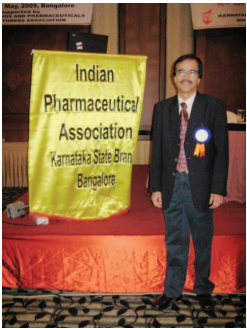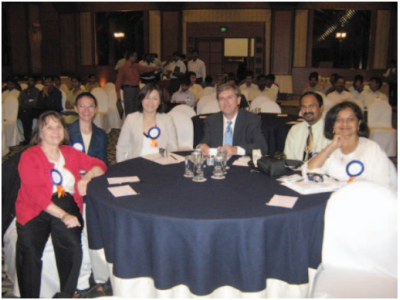
Meeting Report: APQ/IPA Workshop on Challenges for Dissolution Testing in the 21st Century
1President, Analytical Solutions, Inc., Durham, NC
2Research Editor, Dissolution Technologies, Hockessin, DE
A workshop on the Challenges for Dissolution Testing in the 21st Century was held in Bangalore, India on May 15 and 16, 2009. This workshop was jointly sponsored by the In Vitro Release and Dissolution Testing Focus Group of the APQ section of AAPS and the RA Division of Karnataka State Branch of the Indian Pharmaceutical Association. The workshop contents are available at http://www.aapspharmaceutica.com/inside/Focus_Groups/InVitro/index.asp
DAY 1�MAY 15, 2009
Session One
After an elaborate inaugural ceremony that included a presentation of sandalwood garlands to each of the speakers, Dr. B. R. Jagashetty, Drug Controller for the state of Karnataka, gave a keynote address on the importance of dissolution testing in drug development.
Session Two
Introduction to Workshop
Premnath Shenoy
QBD in Analytical Methods and Biowaiver Consideration for
Branded Drug Product
Jianmei Kochling, Genzyme Corporation
Jianmei talked on quality by design in analytical
methods and biowaiver consideration for branded
products. She presented case studies where intrinsic
dissolution results were used to assist in polymorph
selection; moreover, a biorelevant dissolution medium
was used. Other cases studies where the effect of particle
size and surface area/morphology had an effect on the
dissolution rate were presented.
Dissolution Method Development
Saji Thomas, Par Pharmaceuticals
Saji talked on general method development
considerations during product development. He discussed
the considerations during different phases, and while
emphasizing dissolution method development, he
outlined the variables to be considered. After discussing
BCS classification, he outlined the different parameters to
be validated. He then showed Design of Experiments
(DOE) in detail as applied to dissolution method
validation.
Session Three
Citations and Case Studies
Sridhar Rao
Rao's talk was on the compliance to regulations as
related to dissolution testing. Several examples and case
studies of 483s issued due to noncompliance or failures
during dissolution testing were cited. Possible solutions to
address product failure at dissolution stage were offered.
Dissolution Method Transfer, Including Sources of Problems
Vivian Gray, V. A. Gray Consulting, Inc.
Vivian's talk emphasized the source of problems during
transfer of a dissolution method. She pointed out the
importance of robustness checking and the role of
different parameters that affect dosage form dissolution
including the basket, vessels, dissolution medium aeration,
vibration, and bubbles.
Session Four
Challenges in Dissolution Testing and Setting Specification
for Generic Drugs
Saji Thomas, Par Pharmaceuticals
Saji talked on challenges in dissolution method
development for generic products. Examples were given
for an orally disintegrating tablet and an extended-release
product; dissolution profiles and specifications for generic
and RLD products were compared. Recommendations
were given for FDA to use QBD approach for dissolution
testing and setting acceptance criteria.
DAY 2�MAY 16, 2009
Session Five
Dissolution Aberrant Data InvestigationBryan Crist, Varian, Inc.
Bryan Crist talked about the causes of aberrant data during dissolution testing. He went through the process of investigation of OOS results, especially as it relates to dissolution testing, and provided a road map for investigation that includes checking the apparatus, the method, the analyst, and the materials. For each of these, he detailed specific parameters to be checked. Finally, quite a few observations by FDA investigators citing failures in dissolution testing were shown.
Impact of Dissolution in Product Development and Launch Strategy
Indranil Nandi, Sandoz
Indranil talked on the recent aggressiveness of the
generic drug market in launching products within
Paragraph 4 certification. He emphasized the strategy
behind developing a dissolution test that allows no
hurdles in product launch. Several examples were given
where failure during dissolution testing, for either stability
or validation batches, resulted in a delay in product launch.
Session Six
Development of Performance Tests for Semisolid Dosage
Forms within QBD Design Space
Kailas Thakker, Analytical Solutions, Inc.
Kailas talked on developing a performance test for
topical dosage forms in QBD design space. Examples of a
performance test developed for a vaginal gel were given.
The performance test was validated using attributes of
precision, intermediate precision, ruggedness, robustness,
and dose strength proportionality. Examples of the
instances where SUPAC-SS guidance criteria were used to
determine the "sameness" between batches were given.
Dissolution Regulatory GMP Issues, Including Preparing
for a PAI
Vivian Gray, V. A. Gray Consulting, Inc.
Vivian's presentation was focused on GMP compliance
issues surrounding dissolution testing. Examples of issued
citations and 483s that were directly related to dissolution
testing were given. FDA guidances for IR, MR, and SS
dosage forms were cited, and suggestions were given on
avoiding noncompliance to the regulations.
Session Seven
Controls in Dissolution Testing�Type 1 and 2
Sanjay Shetgar, Dr. Reddy's Laboratories
Sanjay talked about the dissolution test, its significance,
and factors affecting the test. Controls such as
instrumental and environmental vibrations, vessel
dimensions, asymmetry, surface irregularity, wobble, shaft
verticality, levelness, and temperature control were listed,
and suggestions for addressing them were made. A
checklist was provided to aid an analyst in checking
various parameters before starting a dissolution test.
Performance Testing in Pharmacation Dosage Forms
Erika Stippler, USP
Erika talked on performance testing for dosage forms.
Dosage forms are classified according to the route of
administration, and the preferred apparatus for each type
of dosage forms was listed (USP <1092>). Critical
parameters affecting dissolution testing were listed, and
the results of studies conducted to measure the effect of
perturbations on the dissolution apparatus and method
were cited. Performance tests for topical, transdermal,
aerosol, parenteral injectables, medicated chewing gums,
and mucosal delivery dosage forms were described.
If you are interested in being involved in the focus group and are a member of AAPS, let the organizers know. For the organizers' e-mail information, contact the Research Editor, vgray@dissolutiontech.com

